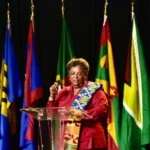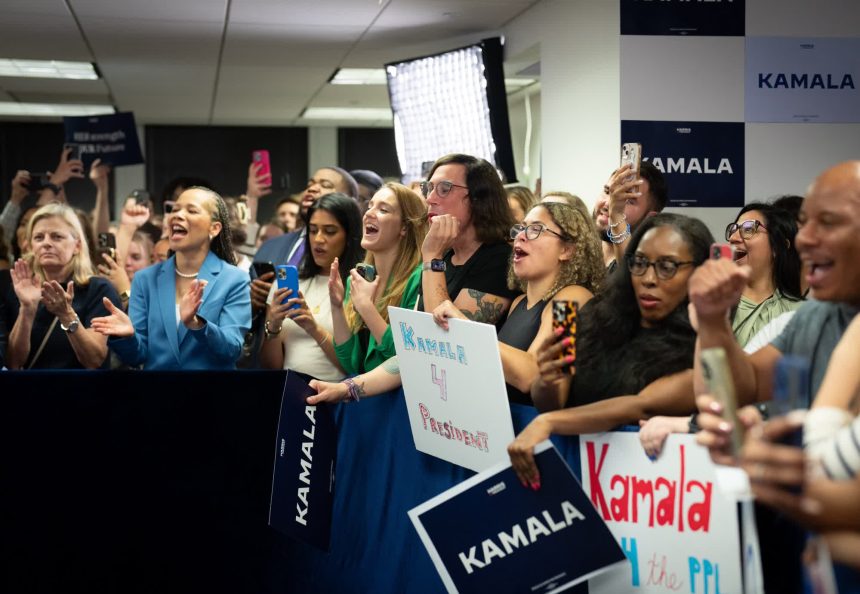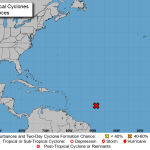Vice President Kamala Harris, quoting her mother, told a group of newly sworn-in commissioners for a White House initiative for Hispanics that their work on education and economic opportunity would be done in the context of their communities.
“You think you just fell out of a coconut tree?” Harris said in May 2023, laughing. “You exist in the context of all in which you live and what came before you.”
It went viral. First, as a criticism of Harris on right-wing social media accounts, including @RNCResearch, the rapid response account of the Republican National Committee. But slowly, then all at once — around the time she became the presumptive Democratic nominee — it was co-opted by her supporters, who remixed and reposted the meme and catapulted Harris onto the “for you page” for TikTok users across the country and globe.
For years as vice president, Harris has been quietly laying the digital groundwork behind the scenes — meeting with young voters, social media influencers and several grassroots organizations. Now, with less than 90 days until the November election, the Harris campaign has made subtle shifts to capitalize on the momentum around her candidacy — and translate her growing social media following into votes.“When we see moments like this go out into this sort of wild, wild west of the internet and be reinterpreted by the people who are there, who are not digital strategists, right, but who are likely teenage girls sitting in their bedrooms creating these fancam edits, making these memes — we see a reinterpretation through their perspective,” said Deja Foxx, a digital strategist, who, at 19, was the youngest member on staff in Harris’ 2020 presidential campaign. It reflects “the power that young people hold not only at the polls, but in defining the narrative,” she added.
Since President Joe Biden stepped aside and endorsed his vice president for the Democratic nomination 20 days ago, the Harris campaign’s digital structure and strategy have largely stayed the same, sources say. But there have been subtle shifts to better reflect the younger nominee at the top of the ticket.
The number of plays Harris’ @KamalaHQ TikTok received for its 65 posts in 20 days is more than double what the @BidenHQ’s 335 posts received in roughly five months.https://edition.cnn.com/interactive/2024/08/politics/harris-social-media-tiktok-dg/#:~:text=Harris%20deputy%20campaign,the%20ballot%20box.
Sohali Vaddula, national director of communications for the College Democrats of America, the youth arm of the Democratic National Committee, told CNN that memes of Harris make her seem more “relatable.”
“It just makes people feel like she’s one of us, like we’re not too far off from her. And it also just resonates with us better,” Vaddula said. “Politics is difficult. All of these policy issues or things that are going on can be really heavy sometimes, and adding memes to that kind of just makes it a little bit more lighthearted.”What Team Biden built
Biden’s campaign built an operation that staffers have long said would be able to reach voters where they were, reflecting the changing ways Americans consume their news, including younger, low-trust voters who are largely tuned out of politics and get much of their information from social media.
The 175 staffers on the team inherited by Harris include a mobilization team, which communicates with grassroots supporters who are sharing or making content, donating money and making calls and sending texts; a digital persuasion operation that encompasses paid media, influencers and content creators; a creative team; and a rapid response team.The group that runs the @KamalaHQ TikTok is very young. Run by Parker Butler, 24, with Lauren Kapp, 25, the five-person Gen Z team has been given training and ground rules — and then “empowered to cook online.”
The team “consists of a lot of young people who just get the internet instinctually,” Butler said in a Friday interview with CNN.
Each campaign social media account has its own personality, with content and format curated to suit its viewers: The campaign’s X account, for instance, is geared toward “political junkies,” Instagram is “very millennial,” Facebook aimed at “older folks” and TikTok for a “young audience,” said Butler.
And there is a focus, Kapp said, on keeping the content “as specific to the trend and the platform as possible — and that’s through small things, like speaking in Gen Z language, and making sure that we aren’t forcing a trend for the sake of doing it.”
Kapp closely tracks the like-to-view ratio as she measures success on TikTok.
“A like on TikTok is basically seen as an endorsement. You can get 50 million views on Tiktok, but if you only get 5,000 likes, then your video’s low-key seen as a flop,” she said.
Since @BidenHQ became @KamalaHQ, Kapp said, the like-to-view ratio has increased from 10-15% to 15-25%.
The team has to be nimble and respond in real time, communicating largely over Slack with a pitching process in place and an emphasis on minimal approval chains.
This week, when Republican vice presidential nominee JD Vance approached Air Force Two in Wisconsin — “to check out my future plane,” as he joked to reporters afterward — Kapp sprung into action. She paired video of Harris greeting a pack of Girl Scouts on the tarmac with video of the nearby Vance plane. She also added trending audio from Abby Lee Miller of “Dance Moms” fame and an eye-rolling emoji caption. The ten-second TikTok got 16.3 million views and 3.7 million likes.










